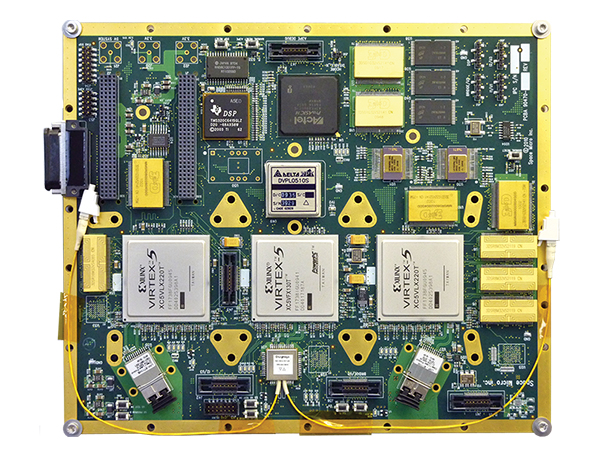
Controller Chips Preserve Microprocessor Function
NASA Technology
Above the Atlantic Ocean, off the coast of Brazil, there is a dip in the Earth’s surrounding magnetic field called the South Atlantic Anomaly. Here, space radiation can reach into Earth’s upper atmosphere to interfere with the functioning of satellites, aircraft, and even the International Space Station. “The South Atlantic Anomaly is a hot spot of radiation that the space station goes through at a certain point in orbit,” Miria Finckenor, a physicist at Marshall Space Flight Center, describes, “If there’s going to be a problem with the electronics, 90 percent of that time, it is going to be in that spot.”
Space radiation can cause physical damage to microchips and can actually change the software commands in computers. When high-energy particles penetrate a satellite or other spacecraft, the electrical components can absorb the energy and temporarily switch off. If the energy is high enough, it can cause the device to enter a hung state, which can only be addressed by restarting the system. When space radiation affects the operational status of microprocessors, the occurrence is called single event functional interrupt (SEFI).
SEFI happens not only to the computers onboard spacecraft in Earth orbit, but to the computers on spacecraft throughout the solar system. “One of the Mars rovers had this problem in the radiation environment and was rebooting itself several times a day. On one occasion, it rebooted 40 times in one day,” Finckenor says. “It’s hard to obtain any data when you have to constantly reboot and start over.”
Partnership
To develop a SEFI controller chip for microprocessors aboard a variety of missions, including earth sensing, solar system, and deep space, Marshall Space Flight Center worked with a San Diego-based company, Space Micro Inc., through the Small Business Innovation Research (SBIR) program in 2002. By the end of a Phase II SBIR, Space Micro developed an advanced technology to mitigate the effects of SEFI by recovering microprocessors in the middle of a hung state, rather than restarting the whole system. Called Hardened-Core, or H-Core, the technology is a combination of hardware and software that allows a system to automatically return to operational status after a SEFI event. If the system happens to be processing data at the time, less of the critical data is lost.
“I think we were innovative to propose the SEFI mitigation technique, and NASA had the foresight to fund it,” says David Strobel, CEO at Space Micro. “The old fashioned way of addressing SEFI is to restart the whole system. With H-Core, the recovery from SEFI is autonomous, and it keeps the system up longer.”
Shortly after the completion of the SBIRs, NASA selected a Space Micro computer, incorporating the SEFI mitigation technology, for use as the core processor for medical equipment computers on the ISS. However, that is not where use of the technology ends.
“Being prepared for SEFI and having more robust computers to deal with SEFI is going to help on missions where there is a lot more radiation than in low Earth orbit,” says Finckenor. “This technology is one that we really saw a chance for success, and that’s what you want from the SBIR program. You want something that the company can continue to develop and commercialize, and that is what Space Micro has done.”
As a testament to the company’s success, in 2011, Space Micro was selected by the Small Business Administration as a winner of the prestigious “Tibbetts Award” in recognition of small businesses and SBIR support organizations exemplifying the types of business, economic, and technical development goals of the SBIR program.
Benefits
As a provider of radiation-hardened solutions for advanced electronic systems and microelectronics, Space Micro takes technologies from the commercial sector and adapts them to meet the needs of space, aerospace, military, and domestic security. Strobel finds working with NASA was an important step in the incorporation of commercial processors in the imaging, signal processing, and space weather satellite industry. Today, the NASA-derived H-Core is embedded in Space Micro’s entire series of high-performance radiation-hardened computers for space: the Proton200k, Proton300k, and Proton400k.
The Proton200k radiation-hardened, single-board computer is flight qualified for space and satellite applications, and is used for command, power, and data handling for micro- and nanosatellites. The enhanced version, the Proton200k-3X, is a triple-core, single-board computer for radiation-hardened digital signal processing for low Earth orbit or geosynchronous orbit. Space Micro’s Proton300k, a space computer platform with reconfigurable field-programmable gate arrays, brings several technologies together to provide high performance, power, and radiation hardening. Lastly, the Proton400k is a 64-bit, dual-core power PC single board computer designed to accommodate various applications for satellite and launch systems.
Strobel finds the development of H-Core happened at just the right time. “Semiconductor processors were getting smaller and smaller, and hangs were becoming more and more prevalent. H-Core was a way to mitigate radiation effects in commercial microelectronics and enable fast, radiation-hardened space processing.”
Customers for Space Micro’s technology represent every prime contractor in the space industry including Lockheed Martin, Boeing, Raytheon, Northrop Grumman, and Alliant Techsystems Inc. The U.S. Air Force, Department of Defense, and NASA have all used the computers with H-Core in a variety of programs.
Space Micro attributes much of its success to the NASA SBIR program. Strobel believes H-Core has helped the company grow from a $1 million dollar company to an $8 million company and be recognized for fast growth several years in a row in Inc. magazine’s list of the “5000 Fastest Growing Private Companies.”
“We’ve expanded from 4 employees at the beginning of the NASA SBIR to 43 employees today,” Strobel says. “I can’t say the one technology created all those jobs, but it has definitely helped.”
Proton200k™, Proton300k™, Proton400k™, and H-Core™ are trademarks of Space Micro Inc.

Through a NASA SBIR, Space Micro Inc. developed Hardened-Core, or H-Core, to mitigate the effects of space radiation. The company now incorporates H-Core into its series of high-performance computers, including the Proton300k shown here.

Space radiation can interfere with the electronics on the International Space Station (ISS). High-energy particles switch electronics off and can cause them to enter a hung state. Here, the ISS is shown with Space Shuttle Endeavor on May 23, 2011.













